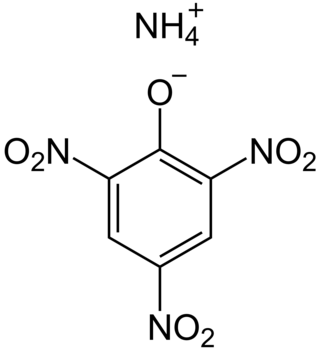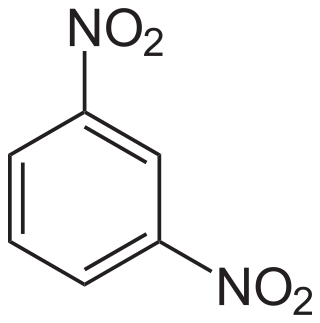Trinitrobenzenes are nitrobenzenes consisting of three nitro groups bonded to a central benzene ring.
There are three isomers of trinitrobenzene:
Trinitrobenzenes are nitrobenzenes consisting of three nitro groups bonded to a central benzene ring.
There are three isomers of trinitrobenzene:

Paiute refers to three non-contiguous groups of indigenous peoples of the Great Basin. Although their languages are related within the Numic group of Uto-Aztecan languages, these three languages do not form a single subgroup and they are no more closely related to each than they are to the Central Numic languages which are spoken between them. The term "Paiute" does not refer to a single, unique, unified group of Great Basin tribes, but is a historical label comprising:
The UK Classical Charts are three record charts based on classical music in the United Kingdom: the Classical Artist Albums Chart, the Classical Compilation Albums Chart and the Specialist Classical Albums Chart. The charts are commercial monitoring and marketing devices used by the UK music industry to measure its effectiveness in promoting and selling albums, nominally in the field of classical music. All three charts are compiled by the Official Charts Company (OCC). The measurements are made by collating the returns of sales from a number of well-known music stores on a regular basis, and this enables a ranking to be established. Most classical artist album sales in the UK are from crossover artists. For an album to be classified as classical in the charts, it has to have 60% of the playing time dedicated to "classical or traditional music". Only albums that entirely classical or traditional music qualify for inclusion in the Specialist Classical Albums Chart.
In chemistry, electron deficiency is jargon that is used in two contexts: chemical species that violate the octet rule because they have too few valence electrons and species that happen to follow the octet rule but have electron-acceptor properties, forming donor-acceptor charge-transfer salts.

Dunnite, also known as Explosive D or systematically as ammonium picrate, is an explosive developed in 1906 by US Army Major Beverly W. Dunn, who later served as chief inspector of the Bureau of Transportation Explosives. Ammonium picrate is a salt formed by reacting picric acid and ammonia. It is chemically related to the more stable explosive trinitrotoluene (TNT).

1,3,5-Triazido-2,4,6-trinitrobenzene, also known as TATNB (triazidotrinitrobenzene) and TNTAZB (trinitrotriazidobenzene), is an aromatic high explosive composed of a benzene ring with three azido groups (-N3) and three nitro groups (-NO2) alternating around the ring, giving the chemical formula C6(N3)3(NO2)3. Its detonation velocity is 7,350 meters per second, which is comparable to TATB (triaminotrinitrobenzene).
Linolenic acid is a type of naturally-occurring fatty acid. It can refer to either of two octadecatrienoic acids, or a mixture of the two. Linolenate is often found in vegetable oils; traditionally, such fatty acylates are reported as the fatty acids:
Nitrobenzenes are a group of nitro compounds consisting of one or more nitro groups as substituents on a benzene core. They have the formula C6H6–n(NO2)n, where n = 1–6 is the number of nitro groups. Depending on the number of nitro groups, there may be several constitutional isomers possible.
TNB may stand for:

Picryl chloride is an organic compound with the formula ClC6H2(NO2)3. It is a bright yellow solid that is highly explosive, as is typical for polynitro aromatics such as picric acid. Its detonation velocity is 7,200 m/s.
In Greek mythology, Borysthenis may refer to two distinct individuals:
Article often refers to:
The Toyota Stallion is a nameplate used on three different pickup truck models by Toyota:
The molecular formula C6H3N3O6 (molar mass: 213.10 g/mol, exact mass: 213.0022 u) may refer to:
Herring gull is a common name for several birds in the genus Larus, all formerly treated as a single species.

Trinitroanisole is a chemical compound that exists as pale yellow crystals with a melting point of 68 °C. It is highly toxic. It is an explosive with a detonation velocity of 7200 meters per second. The compound's primary hazard is a blast of an instantaneous explosion, not flying projectiles or fragments.

PD-217,014 is a drug developed by Pfizer and related to gabapentin, which similarly binds to the α2δ calcium channels. It was developed as a potentially more potent successor to gabapentin and pregabalin, along with several other analogues such as atagabalin and 4-methylpregabalin, but while PD-217,014 produces visceral analgesic effects in animal studies with higher potency and efficacy than gabapentin, it was not developed further for clinical use because of its comparatively more complex synthesis, compared to other related analogues.

1,3-Dinitrobenzene is one of three isomers of dinitrobenzene, with the formula C6H4(NO2)2. It is one of three isomers of dinitrobenzene. The compound is a yellow solid that is soluble in organic solvents.
Betty Wright Harris is an American chemist. She is known for her work on the chemistry of explosives completed at Los Alamos National Laboratory. She patented a spot test for detecting 1,3,5-triamino-2,4,6-trinitrobenzene (TATB) in the field, which is used by the Federal Department of Homeland Security to screen for nitroaromatic explosives.

1,2,3-Trinitrobenzene is an isomer of trinitrobenzene.

2,4,6-Trinitrobenzoic acid (TNBA) is an organic compound with the formula (O2N)3C6H2CO2H. It is a high explosive nitrated derivative of benzoic acid.